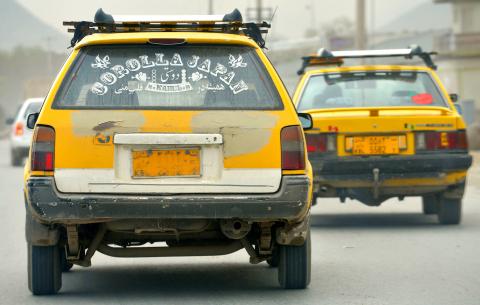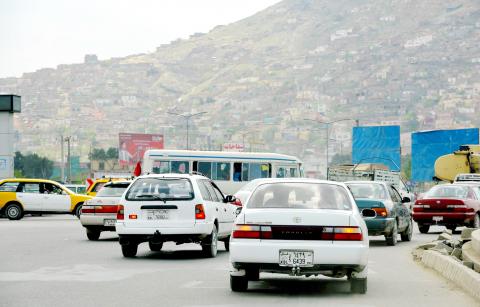Cheap, robust and reliable: Consumer culture may be relatively new to Afghanistan, but when it comes to cars, there is a clear favorite — the trusty Toyota Corolla.
In a country where even paved roads in the smartest parts of the capital are riddled with potholes, the sturdy Japanese-made car is the vehicle of choice for all but the richest.
“There have been Toyota Corollas here before it was even produced in Japan,” jokes Mohammad, a Kabul resident in his 30s who works for a foreign company.

Photo: AFP
Mirwais Nabizada, 38, who has sold used cars in Kabul for 20 years, says that they are popular because they are not as pricey as other vehicles — and spare parts are easy to find.
“Many people buy them because they are robust, cheaper and there are spare parts available everywhere,” he says.
He has 70 cars in his showroom, all but six of them Corollas.

Photo: AFP
They come in all shapes and colors: black, blue, green, yellow or white. Some have tinted windows, some don’t. Others have a curved chassis or square headlights. Old or new, it is always a trusty Corolla sedan.
“White is a favorite of buyers because it shows the dirt less, there is a lot of dust here,” Nabizada says.
On one 10-minute drive between the center of the capital and the embassy district, Agence France-Presse counted 194 Corollas, compared with 89 other cars, buses, trucks and security vehicles.
Owners love them and cherish them. They put stickers on their rear windscreens reading: “Beautiful Corolla,” “Super Saloon Corolla” and “Corolla I love you.”
Experts can recognize whether the vehicle comes originally from North America or Europe from the size of its bumper or the position of its license plate.
Almost all taxis are Corollas and customers who call a cab are not told the make, just to look out for a “gray 2002” or a “brown 2007.”
The head of Kabul traffic police, General Asadullah Khan, says Corollas account for 80 percent of the 700,000 vehicles driving through the congested streets of Kabul — where 500 to 600 new or used vehicles are registered each day.
“The Corolla is the car of the people. It doesn’t use too much gas,” he said.
However, their ubiquity also makes them the weapon of choice for Taliban car bombers, who stash them with explosives and drive unnoticed through checkpoints as they fight against the US-backed government.
With potential buyers wary of growing insecurity when the NATO combat troops leave next year, sales are down as people become more reluctant to spend money on a car when they feel uncertain about what the future holds.
Although they are cheaper than other cars available, Corollas are still no bargain due to high taxes — a dented old wreck costs US$3,500 while a one-year-old with low mileage goes for US$26,000.
Customs fees for each imported car are about US$5,000, plus US$1,500 for licensing and a range of other taxes to be paid on top, says Nabizada, who says that he sells only five a day, down from 10 a few years ago.
Still, existing owners continue to pamper and preserve their beloved Corollas.
“In Islam, cleanliness is an important value,” said Shaker Bakhter, one of the few dealers in Kabul, who says he has sold at least 10,000 Corollas in his career.
And why do Afghans pay so much for their cars?
“You foreigners spend your money by going dancing or bowling. We invest in what is useful,” Bakhter said.

Taiwanese suppliers to Taiwan Semiconductor Manufacturing Co. (TSMC, 台積電) are expected to follow the contract chipmaker’s step to invest in the US, but their relocation may be seven to eight years away, Minister of Economic Affairs J.W. Kuo (郭智輝) said yesterday. When asked by opposition Chinese Nationalist Party (KMT) Legislator Niu Hsu-ting (牛煦庭) in the legislature about growing concerns that TSMC’s huge investments in the US will prompt its suppliers to follow suit, Kuo said based on the chipmaker’s current limited production volume, it is unlikely to lead its supply chain to go there for now. “Unless TSMC completes its planned six

Power supply and electronic components maker Delta Electronics Inc (台達電) yesterday said second-quarter revenue is expected to surpass the first quarter, which rose 30 percent year-on-year to NT$118.92 billion (US$3.71 billion). Revenue this quarter is likely to grow, as US clients have front-loaded orders ahead of US President Donald Trump’s planned tariffs on Taiwanese goods, Delta chairman Ping Cheng (鄭平) said at an earnings conference in Taipei, referring to the 90-day pause in tariff implementation Trump announced on April 9. While situations in the third and fourth quarters remain unclear, “We will not halt our long-term deployments and do not plan to

‘SHORT TERM’: The local currency would likely remain strong in the near term, driven by anticipated US trade pressure, capital inflows and expectations of a US Fed rate cut The US dollar is expected to fall below NT$30 in the near term, as traders anticipate increased pressure from Washington for Taiwan to allow the New Taiwan dollar to appreciate, Cathay United Bank (國泰世華銀行) chief economist Lin Chi-chao (林啟超) said. Following a sharp drop in the greenback against the NT dollar on Friday, Lin told the Central News Agency that the local currency is likely to remain strong in the short term, driven in part by market psychology surrounding anticipated US policy pressure. On Friday, the US dollar fell NT$0.953, or 3.07 percent, closing at NT$31.064 — its lowest level since Jan.

The New Taiwan dollar and Taiwanese stocks surged on signs that trade tensions between the world’s top two economies might start easing and as US tech earnings boosted the outlook of the nation’s semiconductor exports. The NT dollar strengthened as much as 3.8 percent versus the US dollar to 30.815, the biggest intraday gain since January 2011, closing at NT$31.064. The benchmark TAIEX jumped 2.73 percent to outperform the region’s equity gauges. Outlook for global trade improved after China said it is assessing possible trade talks with the US, providing a boost for the nation’s currency and shares. As the NT dollar